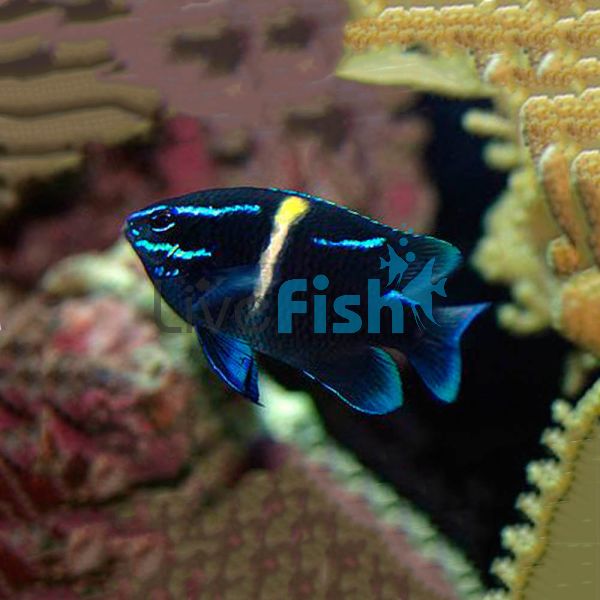Javanese Blue Streak Damselfish - Medium
The Javanese Bluestreak Damselfish is at its most attractive during the juvenile stage. Its combinations of neon flashes and stripes really make it an eye-catching species.
- Buy 4 for $33.32 each and save 10%
The Javanese Bluestreak stands out with the bright electric blue stripes on youngsters. These appear above and below its eyes, running across the head and face. They are also visible on the upper body by the dorsal fin and at the base of the tailfin. The contrast against a dark body, gives the stripes an amazingly bright appearance. This species also has a vertical white or yellow stripe which runs down the middle of its body. As they mature these stripes can start to fade with adults developing a grey/blue or brownish colour. When fully grown, adults can reach a length of 6 inches (15.2 centimeters).
Javanese Bluestreak Damsels don't have any known visible sexual differences, but males can be bigger. Males may also use a courtship display when attracting a mate. There aren't any reports of captivity breeding. In the wild they need spawning temperatures of 79°F to 83°F (26°C to 28°C). Males will attract a succession of females to their nest and fertilize the eggs they deposit. The males guard the eggs until they hatch and start to feed on plankton.
Their natural habitat is in the Western Pacific and Indo-Australian Archipelago regions. In locations such as the Philippines, Indonesia, and Timor Sea. They are usually found near small, stony Acropora corals, in reefs and lagoons. They prefer a decent current and stay relatively shallow in depths of less than 4 meters (13 feet).
Tank Recommendations for your Javanese Bluestreak Damselfish
Javanese Bluestreaks need a tank that is a least 55 gallons (208.2 liters) for a single fish or a mated pair. 100 gallons (379 litres) is recommended if you are keeping it with other fish.
They are suitable for a reef or fish only aquarium but need more space than other damselfish due to their size. Using live rock with algae growth can offer them feeding options. Arranging rock to offer hiding places benefits juveniles and reduces aggression in adults.
There should be an area in the tank with strong water movement, like in their natural habitat.
Suitable Tank Buddies
Javanese Bluestreaks will become aggressive and territorial as they mature. The best option is to keep one alone or house a mated pair.
They are generally safe with corals but may show aggression to decorative invertibrates.
Usually Compatible
Fish with a similar temperament such as Dottybacks, in tanks over 100 gallons (379 litres). Aggressive Angelfish, Triggerfish and large Wrasse in tanks over 200 gallons (757 litres).
Sometime Compatible
Only attempt other Damselfish if they have a similar temperament and the tank is over 200 gallons (757 litres). Make sure more aggressive predators aren't big enough to swallow a Javanese Bluestreak. Eels should be ok as long as they are one of the more docile species.
Rarely Compatible
Peaceful fish such as Gobies, Fairy Wrasse, Anthias cannot co-habit. Small semi-aggressive fish such as Clownfish or Dwarf Angels will also have difficulty. Seahorses and Pipefish are too delicate.
Feeding your Javanese Bluestreak Damselfish
Javanese Bluestreak Damsels are omnivores. They will eat a variety of vegetable based and meaty foods. This can be offered live, freeze dried or frozen. Suitable products include vitamin enriched brine shrimp, mysis shrimp and krill. Fish flesh or shrimp which is finely chopped can also be included. They will eat algae in the tank as well as food flakes or pellets. Feeding should be twice a day, or once day if they are consuming plenty of algae in the tank.
| Scientific Name | Neoglyphidodon oxyodon |
|---|---|
| Care Level | Easy |
| Common Names | Javanese Bluestreak Damselfish, Blue Velvet Damsel, Neon Velvet Damsel, Javanese Damselfish, Black Velvet Damsel, Jewel Damselfish, Velvet Damselfish, Bluebanded Damselfish. |
| Diet | Omnivore |
| Fish Family | Pomacentridae |
| Lifespan (years) | 12 |
| Max. Length (cm) | 15 |
| Min. Tank Volume (l) | 208 |
| Origin | Western Pacific and Indo-Australian Archipelago - Philippines, Indonesia, and Timor Sea |
| Reef Safe | Yes |
| Sociability | Aggressive |
| Venomous | No |
| Water Conditions | 23.3 to 28.9° C, dKH 8-12, pH 8.0-8.3, sg 1.023-1.025 |




